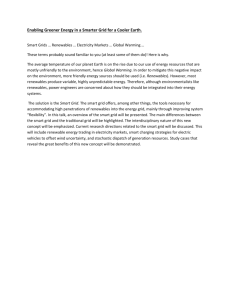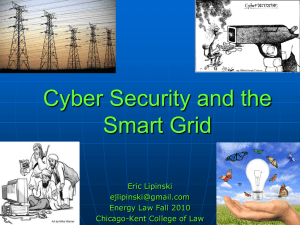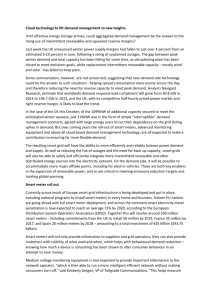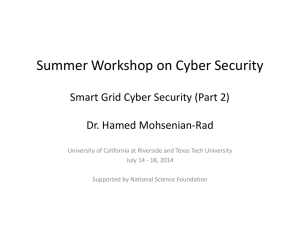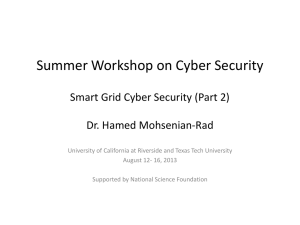Under Andrewʼs Watchful Eye
advertisement
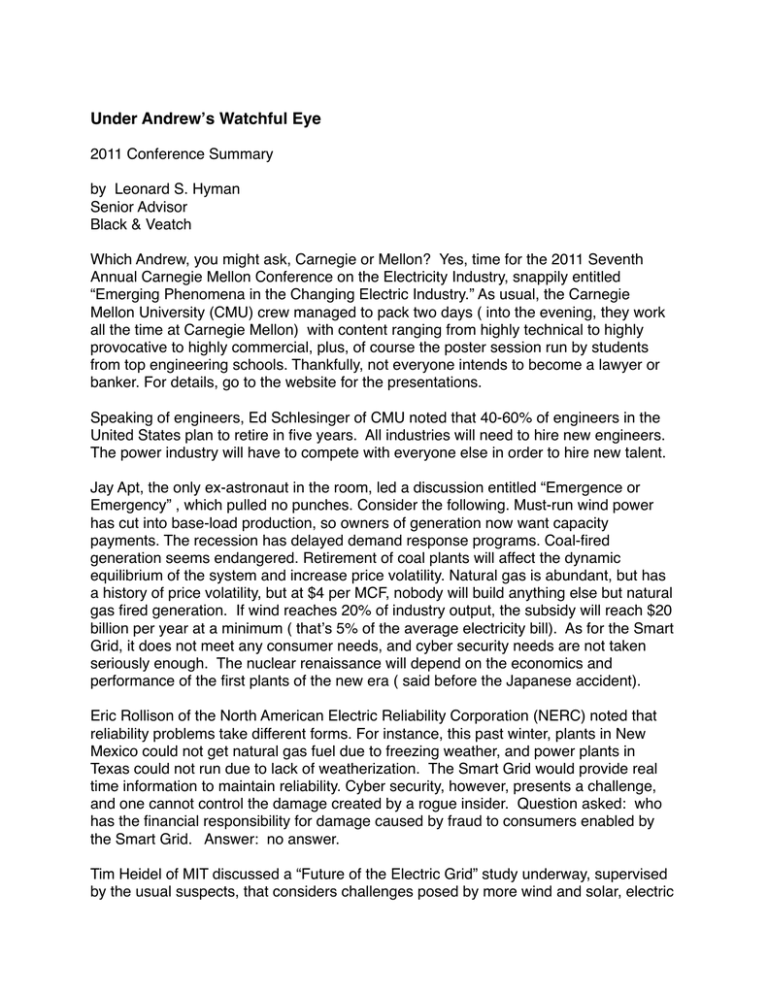
Under Andrewʼs Watchful Eye 2011 Conference Summary by Leonard S. Hyman Senior Advisor Black & Veatch Which Andrew, you might ask, Carnegie or Mellon? Yes, time for the 2011 Seventh Annual Carnegie Mellon Conference on the Electricity Industry, snappily entitled “Emerging Phenomena in the Changing Electric Industry.” As usual, the Carnegie Mellon University (CMU) crew managed to pack two days ( into the evening, they work all the time at Carnegie Mellon) with content ranging from highly technical to highly provocative to highly commercial, plus, of course the poster session run by students from top engineering schools. Thankfully, not everyone intends to become a lawyer or banker. For details, go to the website for the presentations. Speaking of engineers, Ed Schlesinger of CMU noted that 40-60% of engineers in the United States plan to retire in five years. All industries will need to hire new engineers. The power industry will have to compete with everyone else in order to hire new talent. Jay Apt, the only ex-astronaut in the room, led a discussion entitled “Emergence or Emergency” , which pulled no punches. Consider the following. Must-run wind power has cut into base-load production, so owners of generation now want capacity payments. The recession has delayed demand response programs. Coal-fired generation seems endangered. Retirement of coal plants will affect the dynamic equilibrium of the system and increase price volatility. Natural gas is abundant, but has a history of price volatility, but at $4 per MCF, nobody will build anything else but natural gas fired generation. If wind reaches 20% of industry output, the subsidy will reach $20 billion per year at a minimum ( thatʼs 5% of the average electricity bill). As for the Smart Grid, it does not meet any consumer needs, and cyber security needs are not taken seriously enough. The nuclear renaissance will depend on the economics and performance of the first plants of the new era ( said before the Japanese accident). Eric Rollison of the North American Electric Reliability Corporation (NERC) noted that reliability problems take different forms. For instance, this past winter, plants in New Mexico could not get natural gas fuel due to freezing weather, and power plants in Texas could not run due to lack of weatherization. The Smart Grid would provide real time information to maintain reliability. Cyber security, however, presents a challenge, and one cannot control the damage created by a rogue insider. Question asked: who has the financial responsibility for damage caused by fraud to consumers enabled by the Smart Grid. Answer: no answer. Tim Heidel of MIT discussed a “Future of the Electric Grid” study underway, supervised by the usual suspects, that considers challenges posed by more wind and solar, electric vehicles, data communications and cyber security. The industry will have smart meters in place by 2030 because it will have to retire the old meters in place, anyway, so why not put in smart ones? The smart meters will not pay for themselves without demand response. Nobody has a clue as to the potential penetration of electric vehicles. Without control over when they charge, the distribution grid would need enhancement. Howard Lipson, one of those CMU experts who concentrate on cyber security, provided a heavy dose of sobriety. Large, highly distributed systems cannot be isolated from potential intruders. Complexity provides opportunities for attackers. The sophistication of attackers is growing. Security cannot be absolute, so systems managers should concentrate on survivability. Systems must operate after a successful attack, that is, fulfill their missions during and after attack. One cannot build a fortress, so assume that no system is immune to attack. The system needs the ability to gracefully degrade to a minimum level of service. In effect, the system must think instinctively, because analytical thinking takes too much time. Jay Apt returned to the topic of renewable energy sources operating on a large scale, with these sobering thoughts. Weather conditions change downwind of wind mills. capacity factors are lower for new wind turbines, possibly indicating that the better wind sites have already been taken. wind could suffer droughts, perhaps half the magnitude of the familiar hydro drought. Solar has greater variability than wind. The fossil fueled turbines placed in service to regulate for renewables produce pollutants. Putting in batteries, though, mitigates wind variability. Wind needs fill-in power. Marija Ilic of CMU characterized the Smart Grid as a means to manage relationships within systems. If operators within a region manage their sector well, then, even with weak interconnections to elsewhere, the system will work well.It is difficult to achieve efficiency nd reliability. In order to make the most of available resources, the system owners need to consider steps other than just adding wires. resources should be aligned with the needs of users. After the CMU openers, 45 or so presenters covered a multitude of topics, all of which can be found in the conference papers, so look them up. Here are a few highlights: ● What do consumers get out of smart meters? They have to pay more to get them. Seventy percent of households have broadband, and many have wireless. Why do utilities need to build an entirely new infrastructure for smart grid? How will the industry meet security requirements for electricity? ● Advanced lithium ion batteries used on the grid can prevent blackouts. ● Utility operators donʼt know the capacity of the backbone system. They need to know thermal and electrical capacity in order to optimize the system. Sensors can provide the information and thereby open existing assets to more use. ( In other words, make better use of existing wires before building new ones.) ● How to achieve a large blackout? Start with a small one and let it propagate. ● Complex systems are highly unpredictable and interdependent. ● Reliability supervisors should look to outcomes rather than setting rules of procedure. Specify outcome, not methods. ● Physical rather than cyber security is more important, but cyber becomes more important when intelligence is in the grid. ● Deep penetration of renewables presents problems because renewables are not despatchable on demand, are intermittent and uncertain. ● Microgrids, small grids capable of disconnect from the grid, provide an alternative to transmission. ● By 2013, new installations of photovoltaics could overtake those of wind. ● The system needs dynamic ratings for lines, that is, ratings for capacity based on conditions, which would enable the existing system to carry more electricity with a cost of 5% of the next line upgrade. ● Big problem in security: protection of the “last mile” line from the meter to the data access device. No meter is secure. ● A high assurance smart grid requires defense in depth. It must manage risk, because it canʼt avoid risk. The system owner has no control over threats. The system requires protection from the insider knuckleheads, and must engineer them out of the system. ● Load control is required because loads are not smart enough to manage themselves. ●Advanced batteries in the network would increase dynamic stability and permit integration of renewables, and could prevent cascading outages. ● Robustness means that the system maintains its functions ( until it breaks). Resilience means that the system downgrades gracefully and then can self-recover ( from unanticipated failures). ●There is no chance of a carbon tax but pricing is needed to get least cost solutions. Blackouts have huge social costs. Wind is not fully despatchable, and is unpredictable. Better forecasting might result if people had to pay when they forecasted badly. ( the UK makes those who err pay.) ● Integration of renewables increases the stress on the system, and may lower energy prices and raise capacity prices. Okay, thatʼs a fraction of what was said. You can find the presentations ( but not the lively discussion) on the internet. Now, hereʼs the question that always bugs me: why donʼt electric utility people flock to these conferences that provide inexpensive windows on technological change? Donʼt they have any intellectual curiosity? They go to EPRI meetings instead? Check out their contributions to EPRI. You need a microscope to find EPRI expenditures in their budgets. Perhaps they work for organizations that set budgets first, and have no money available for anything the boss did not think of in advance, or care about because budget comes ahead of accomplishment. Electric utilities used to put money into venture capital funds in order to get a handle on new technologies, but they gave up on that, too. The bean counters and the lawyers seem to have taken over from the engineers and visionaries, and their crystal balls, I guess, do not require a view beyond the next quarter. Maybe that should be a topic in the next conference. To conclude, though, as they say, “Next year in Pittsburgh.”
